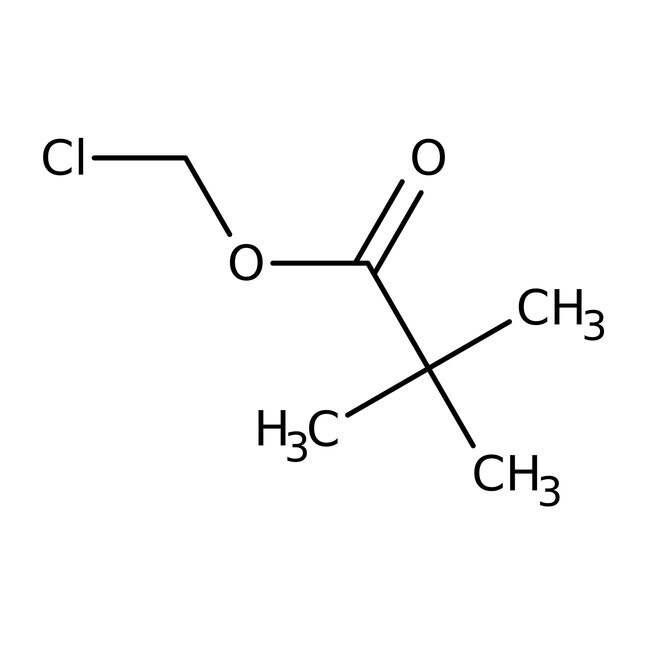Search Thermo Fisher Scientific
Thermo Scientific Chemicals
Chloromethyl pivalate, 97%, Thermo Scientific Chemicals
Catalog number: A11967.22
100 g, Each



Thermo Scientific Chemicals
Chloromethyl pivalate, 97%, Thermo Scientific Chemicals
Catalog number: A11967.22
100 g, Each
Quantity
Catalog number: A11967.22
also known as A11967-22
Price (USD)
83.40
Each
Quantity
-
Have Questions?
Chemical Identifiers
CAS
18997-19-8
IUPAC Name
chloromethyl 2,2-dimethylpropanoate
Molecular Formula
C6H11ClO2
InChI Key
GGRHYQCXXYLUTL-UHFFFAOYSA-N
SMILES
CC(C)(C)C(=O)OCCl
Specifications
Appearance (Color)
Clear colorless to pale yellow
Identification (FTIR)
Conforms
Assay (GC)
≥96.0%
Refractive Index
1.4145-1.4195 @ 20°C
Form
Liquid
Description
Chloromethyl pivalate acts as an intermediate in the synthesis of active pharmaceutical ingredients. It is also involved in the acylation reaction with 9-(2-phosphonylmethoxyethyl)adenine. It serves as a protecting reagent used for the N-protection of amines. It is also employed in the preparation of pivaloyloxy methyl ester of ofloxacin as a prodrug. Further, it is used to prepare sulbactam pivoxil by reaction with sodium salt of sulbactam. In addition to this, it is used as a reagent during the synthesis of an isoindoline-annulated and continuous-flow organic synthesis.
This Thermo Scientific Chemicals brand product was originally part of the Alfa Aesar product portfolio. Some documentation and label information may refer to the legacy brand. The original Alfa Aesar product / item code or SKU reference has not changed as a part of the brand transition to Thermo Scientific Chemicals.
Applications
Chloromethyl pivalate acts as an intermediate in the synthesis of active pharmaceutical ingredients. It is also involved in the acylation reaction with 9-(2-phosphonylmethoxyethyl)adenine. It serves as a protecting reagent used for the N-protection of amines. It is also employed in the preparation of pivaloyloxy methyl ester of ofloxacin as a prodrug. Further, it is used to prepare sulbactam pivoxil by reaction with sodium salt of sulbactam. In addition to this, it is used as a reagent during the synthesis of an isoindoline-annulated and continuous-flow organic synthesis.
Solubility
Miscible with most organic solvents. Immiscible with water.
Notes
Incompatible with strong oxidizing agents.
Chloromethyl pivalate acts as an intermediate in the synthesis of active pharmaceutical ingredients. It is also involved in the acylation reaction with 9-(2-phosphonylmethoxyethyl)adenine. It serves as a protecting reagent used for the N-protection of amines. It is also employed in the preparation of pivaloyloxy methyl ester of ofloxacin as a prodrug. Further, it is used to prepare sulbactam pivoxil by reaction with sodium salt of sulbactam. In addition to this, it is used as a reagent during the synthesis of an isoindoline-annulated and continuous-flow organic synthesis.
Solubility
Miscible with most organic solvents. Immiscible with water.
Notes
Incompatible with strong oxidizing agents.
RUO – Research Use Only
Figures
Documents & Downloads
Certificates
Search by lot number or partial lot number
Frequently asked questions (FAQs)
Citations & References
Search citations by name, author, journal title or abstract text